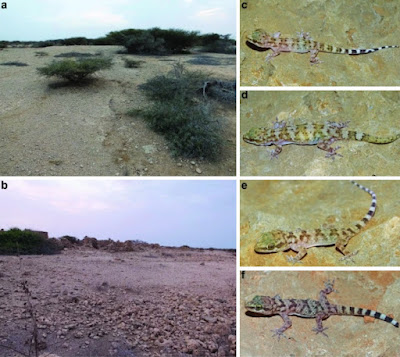Abstract
The systematic, phylogenetic, and biogeographic aspects of the rich squamate fauna of the Arabian Peninsula are becoming increasingly well understood. The Arabian members of the gecko genus Hemidactylus, the most diverse genus among Arabian squamates, have been the subject of several phylogenetic revisions in recent years. However, large parts of the peninsula lacked thorough sampling, for example, the coastal hyper-arid plains along the Red Sea and some offshore islands. In this study, we examine the genetic, morphological, and ecological diversification of a Hemidactylus clade that straddles the Red Sea and contains ten Arabian and three African species. We compiled a genetic dataset of seven markers (two mitochondrial and five nuclear) to reconstruct their phylogenetic relationships and collected morphological data to assess the level of interspecific morphological disparification. Our results support the existence of four yet undescribed species within the clade – two from Arabia and two from Ethiopia. We provide taxonomic descriptions of the two new Arabian species, one from the western Asir Mountains foothills and one from the Farasan Islands. The new species from the Asir Mountains foothills highlights the role of the southern Arabian coastal desert as an important yet often overlooked local biodiversity hotspot. The new species from the Farasan Islands represents the second vertebrate species endemic to the archipelago. Together with the descriptions of the diagnostic features of both species, we provide complete annotated mitochondrial genomes of both holotypes and of holotypes of two other species from the clade to characterize their mitogenomic composition and architecture.
Keywords: Afro-Arabia, Genomics, Lizards, Mitogenome, Reptiles, Squamata
Hemidactylus almakhwah sp. n.
Proposed English name: Al Makhwah gecko.
Proposed Arabic name: Burs Al Makhwah, بُرْصْ الـمَخْواة.
Chresonymy: Hemidactylus sp. 13 in Carranza et al. (2018);
Vasconcelos and Carranza (2014)
Etymology: The species epithet refers to the city and governorate of Al Makhwah, in the vicinity of which most specimens were collected. It is a noun in apposition.
Hemidactylus farasani sp. n.
Proposed English name: Farasan gecko.
Proposed Arabic name: Al Burs Al Farasani, الــبُرْصُ الفَرَسَّانِي.
Chresonymy: Hemidactylus turcicus in Cunningham (2010);
Masseti (2014);
Mertens (1965);
Schätti and Gasperetti (1994)
Etymology: The species epithet is a noun in apposition and refers to the native inhabitants of the Farasan Islands, the Farasani people.
Conclusions:
Southwestern Arabia supports a high richness of squamate reptiles, with Hemidactylus being the most diverse genus. We here identify and describe two new species from previously little explored regions – coastal deserts and the Red Sea islands. We show the phylogenetic positions of the new species within the SW Arabian radiation of the genus and assess the morphological and ecological disparification of the clade. As an important addition, we provide complete mitochondrial genomes for the holotypes of the newly described species as well as for holotypes of two other species from the clade to characterize their mitogenomic composition and architecture. Thus, the name-bearing specimens of the species will be permanently associated with their complete mitogenomic sequences, which will have key implications for future taxonomic and phylogenetic studies on the genus.
Jiří Šmíd, Marek Uvizl, Mohammed Shobrak, Salem Busais, Al Faqih Ali Salim, Raed Hamoud M. AlGethami, Abdulaziz Raqi AlGethami, Abdulkarim Saleh K. Alanazi, Saad Dasman Alsubaie, Michail Rovatsos, Lucie Nováková, Tomáš Mazuch and Salvador Carranza. 2022. Diversification of Hemidactylus Geckos (Squamata: Gekkonidae) in coastal Plains and Islands of southwestern Arabia with Descriptions and Complete Mitochondrial Genomes of Two Endemic Species to Saudi Arabia. Organisms Diversity & Evolution. DOI: 10.1007/s13127-022-00572-w


